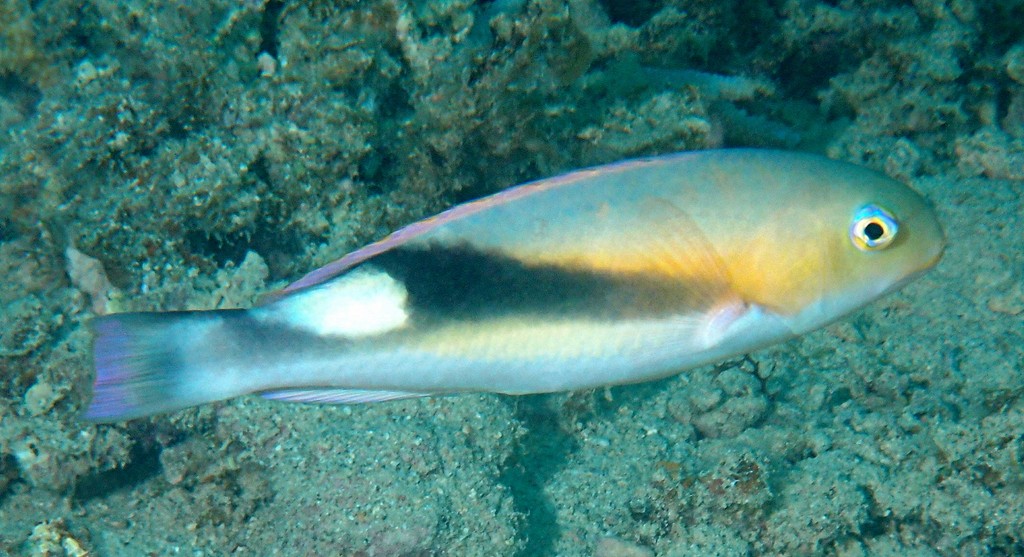CHOERODON JORDANI - (SNYDER, 1908)
Actinopterygii (Gigaclass) > Actinopteri (Class) > Teleostei (Subclass) > Labriformes (Order) > Labroidei (Suborder) > Labridae (Family) > Choerodon (Genus)
Jordan's tuskfish, Jordan's wrasse, Blackwedge tuskfish, Dagger tuskfish, Kurakakebera, クラカケベラ, 喬氏豬齒魚, 乔氏猪齿鱼,
Synonyme
Choerops jordani (Snyder, 1908)
--------------------------
Description
Dorsal spines (total): 13; Dorsal soft rays (total): 7; Anal spines: 3; Anal soft rays: 10; Scales in lateral line: 27; Between lateral line and base of dorsal: 2; Between lateral line and origin of anal, counting upward and forward: 9. Anterior contour strongly arched; Lower jaw projecting slightly beyond the upper; Interorbital region convex, a little less so than the occiput; Mouth rather large, the concealed maxillary extending to a vertical through anterior edge of pupil. Inner teeth coalesced, the cutting edge rather narrow laterally but becoming broadened anteriorly, the plates of upper jaw having a pair of small teeth at the symphysis; 4 widely spaced canine teeth in each jaw, the outer, lower ones largest, curved backward; Each of the median upper pair with a small canine at its base; Posterior canines large. Gill rakers very short, slender, and pointed, 7-8 on lower limb of first arch. Preopercle very finely serrated. Scales of cheek in 5 rows, small and nonimbricate; Occiput and border of preopercle naked; 6 scales in a line between first dorsal spine and the occiput. Lateral line following contour of body to a point below beginning of soft dorsal, where it bends downward and then passes along middle of caudal peduncle. Dorsal spines highest posteriorly, the longest contained 3.2 in head; Longest ray: 2.8; Dorsal and anal projecting an equal distance posteriorly, not reaching base of caudal. Caudal truncate, the tips of upper rays projecting; Length: 1.5 in head. Ventrals: 1.5 in head, their tips just reaching anal opening. Pectoral fin: 1.3 in head. Max. length: 17.0 cm TL. Depth range: 5 - 73 m, usually: 15 - 30 m .
Color
A fish with broad yellow lateral stripe becoming blackish towards to rear, and a large pale oval patch below the rear of the dorsal fin base, and the on upper part of the caudal fin base and adults with the upper margin of the caudal fin dark.
Etymology
Choerodon: from Greek, choiros = a pig + from Greek, odous = teeth. Referring to prominent anterior canines, which Bleeker called “slagtanden” (tusks), hence the common name tuskfish.
jordani: named for President David Starr Jordan (1851 - 1931) of Stanford University. He was an American ichthyologist, educator, eugenicist, and peace activist. He was president of Indiana University and the founding president of Stanford University.
Original description: Choerops jordani Snyder, 1908 - Type locality: Naha market, Okinawa Island, Ryukyu Islands, Japan.
Distribution
Eastern Indian Ocean and western Pacific: southern China, Taiwan, Japan; Northern Australia and New Caledonia, east to Fiji.
Biology
Adults are usually found on substrata of sand, rubble, or small coral heads near reefs. Oviparous, distinct pairing during breeding. A protogynous hermaphrodite, with females changing sex to become males during their life cycle. Aquarium fish.
Last update: 14, October 2024
Jordan's tuskfish, Jordan's wrasse, Blackwedge tuskfish, Dagger tuskfish, Kurakakebera, クラカケベラ, 喬氏豬齒魚, 乔氏猪齿鱼,
Synonyme
Choerops jordani (Snyder, 1908)
--------------------------
Description
Dorsal spines (total): 13; Dorsal soft rays (total): 7; Anal spines: 3; Anal soft rays: 10; Scales in lateral line: 27; Between lateral line and base of dorsal: 2; Between lateral line and origin of anal, counting upward and forward: 9. Anterior contour strongly arched; Lower jaw projecting slightly beyond the upper; Interorbital region convex, a little less so than the occiput; Mouth rather large, the concealed maxillary extending to a vertical through anterior edge of pupil. Inner teeth coalesced, the cutting edge rather narrow laterally but becoming broadened anteriorly, the plates of upper jaw having a pair of small teeth at the symphysis; 4 widely spaced canine teeth in each jaw, the outer, lower ones largest, curved backward; Each of the median upper pair with a small canine at its base; Posterior canines large. Gill rakers very short, slender, and pointed, 7-8 on lower limb of first arch. Preopercle very finely serrated. Scales of cheek in 5 rows, small and nonimbricate; Occiput and border of preopercle naked; 6 scales in a line between first dorsal spine and the occiput. Lateral line following contour of body to a point below beginning of soft dorsal, where it bends downward and then passes along middle of caudal peduncle. Dorsal spines highest posteriorly, the longest contained 3.2 in head; Longest ray: 2.8; Dorsal and anal projecting an equal distance posteriorly, not reaching base of caudal. Caudal truncate, the tips of upper rays projecting; Length: 1.5 in head. Ventrals: 1.5 in head, their tips just reaching anal opening. Pectoral fin: 1.3 in head. Max. length: 17.0 cm TL. Depth range: 5 - 73 m, usually: 15 - 30 m .
Color
A fish with broad yellow lateral stripe becoming blackish towards to rear, and a large pale oval patch below the rear of the dorsal fin base, and the on upper part of the caudal fin base and adults with the upper margin of the caudal fin dark.
Etymology
Choerodon: from Greek, choiros = a pig + from Greek, odous = teeth. Referring to prominent anterior canines, which Bleeker called “slagtanden” (tusks), hence the common name tuskfish.
jordani: named for President David Starr Jordan (1851 - 1931) of Stanford University. He was an American ichthyologist, educator, eugenicist, and peace activist. He was president of Indiana University and the founding president of Stanford University.
Original description: Choerops jordani Snyder, 1908 - Type locality: Naha market, Okinawa Island, Ryukyu Islands, Japan.
Distribution
Eastern Indian Ocean and western Pacific: southern China, Taiwan, Japan; Northern Australia and New Caledonia, east to Fiji.
Biology
Adults are usually found on substrata of sand, rubble, or small coral heads near reefs. Oviparous, distinct pairing during breeding. A protogynous hermaphrodite, with females changing sex to become males during their life cycle. Aquarium fish.
Last update: 14, October 2024
